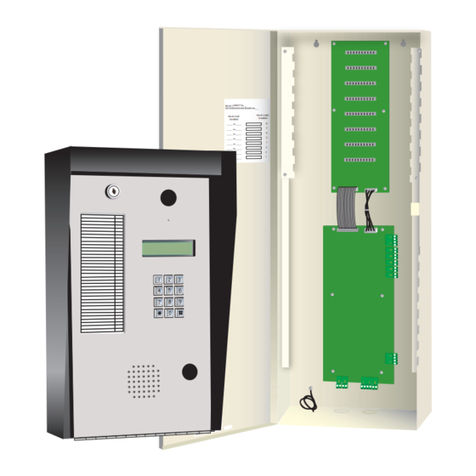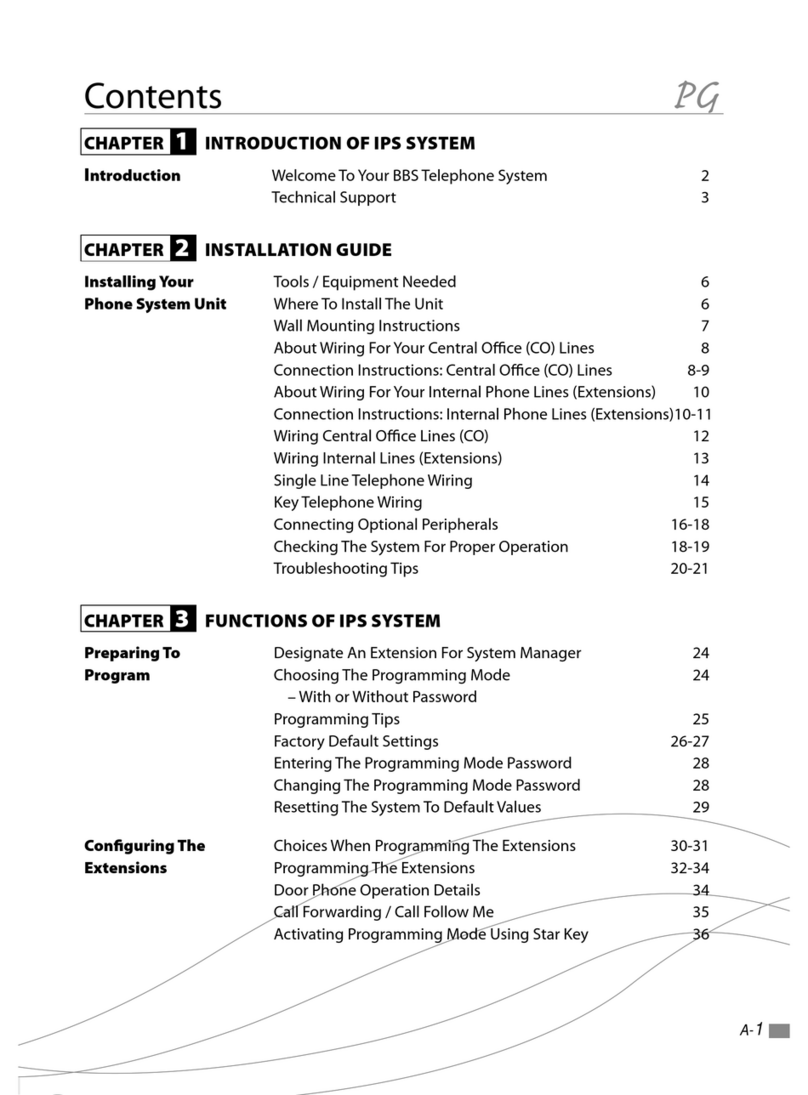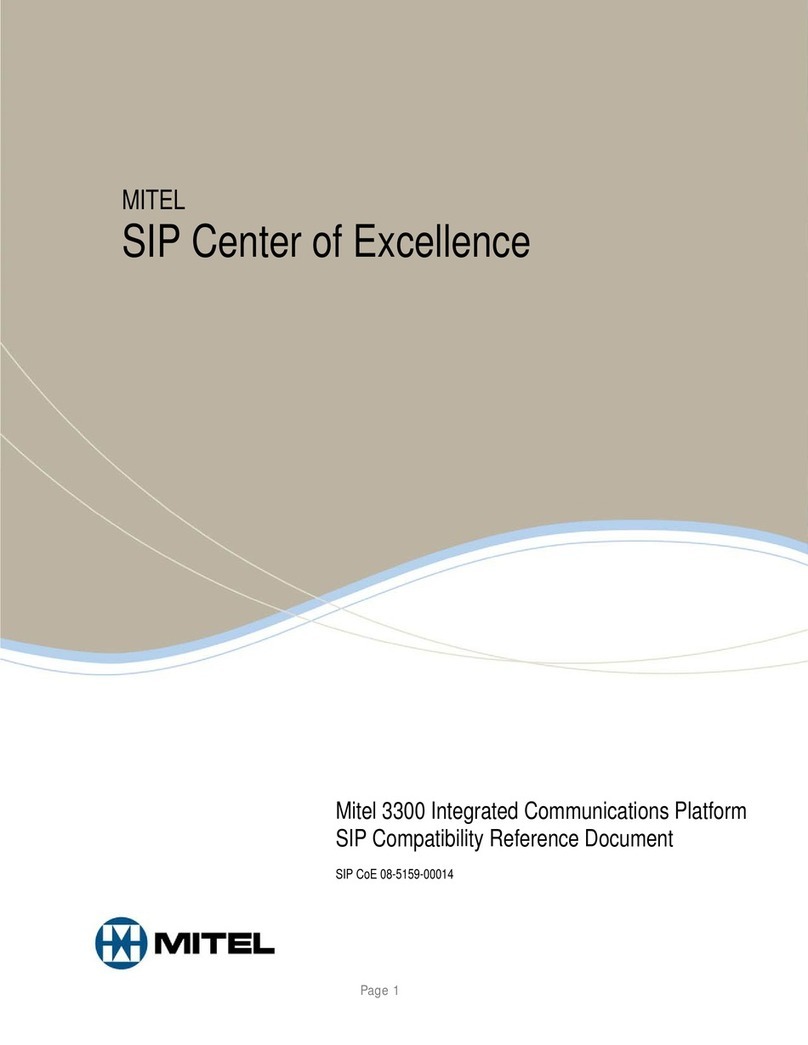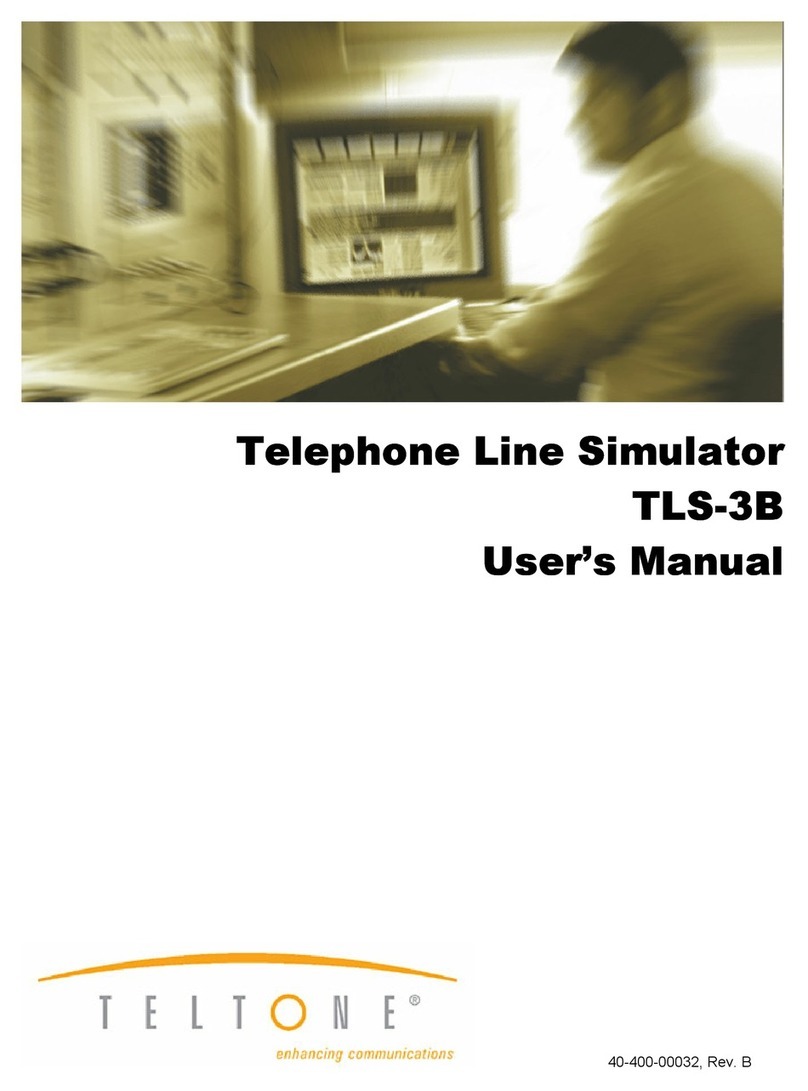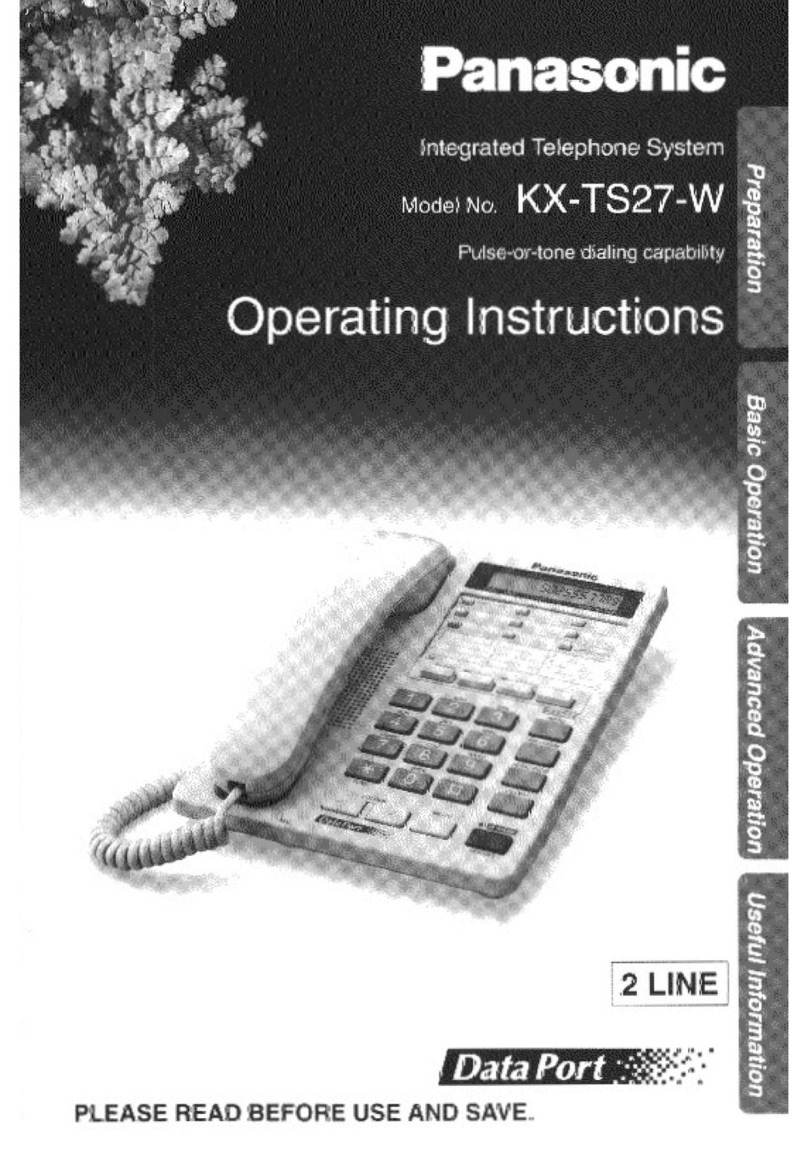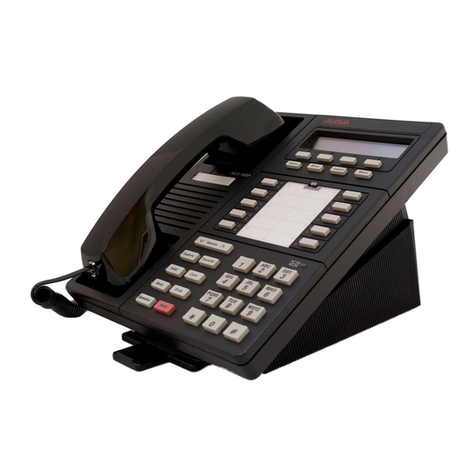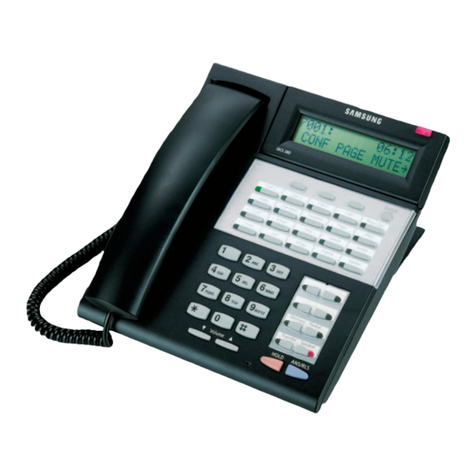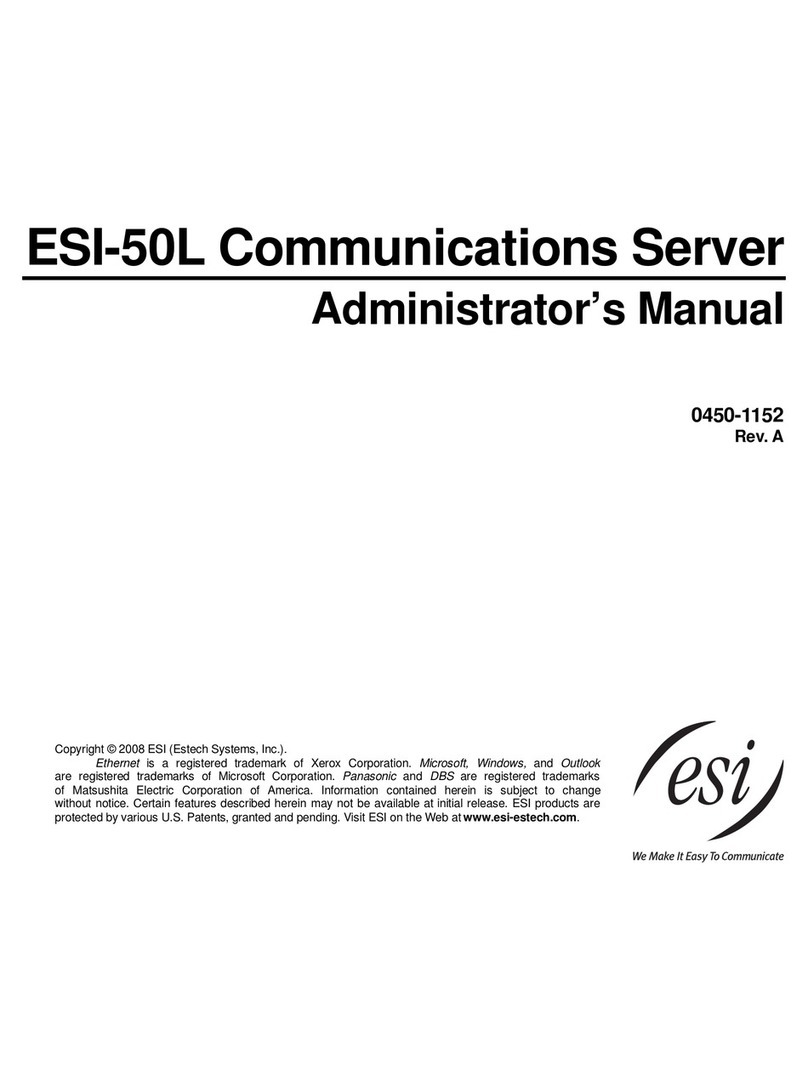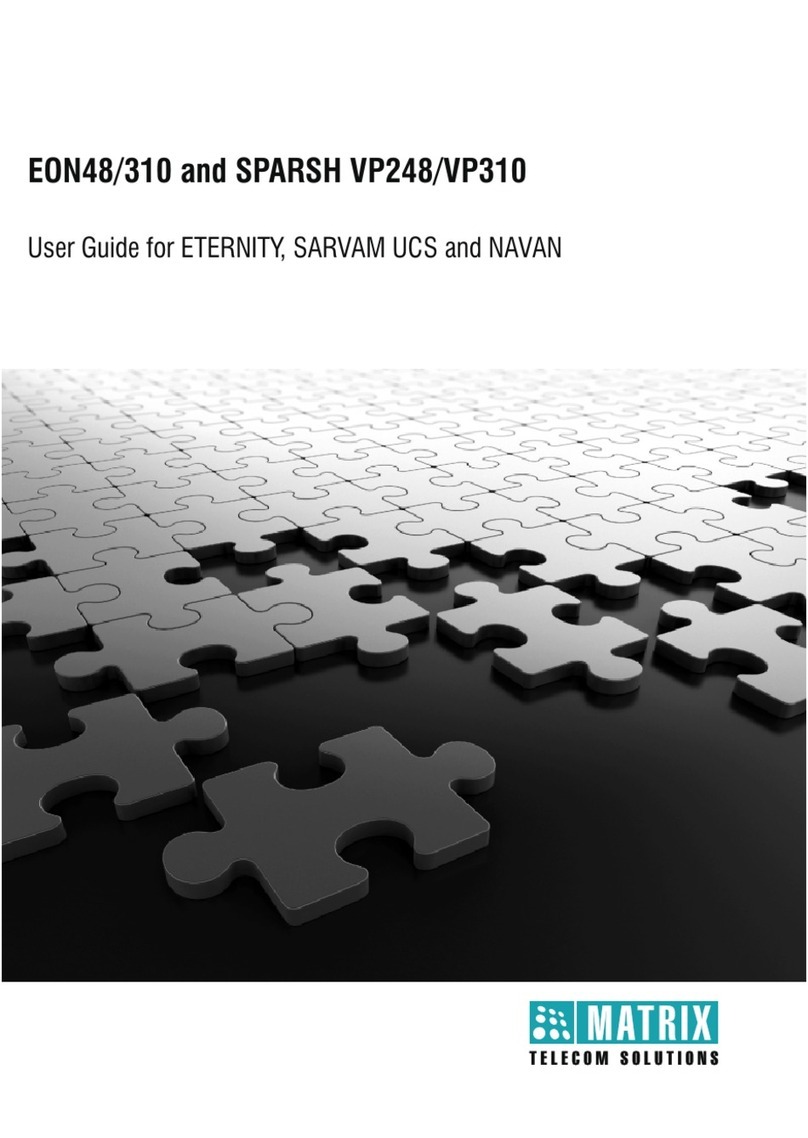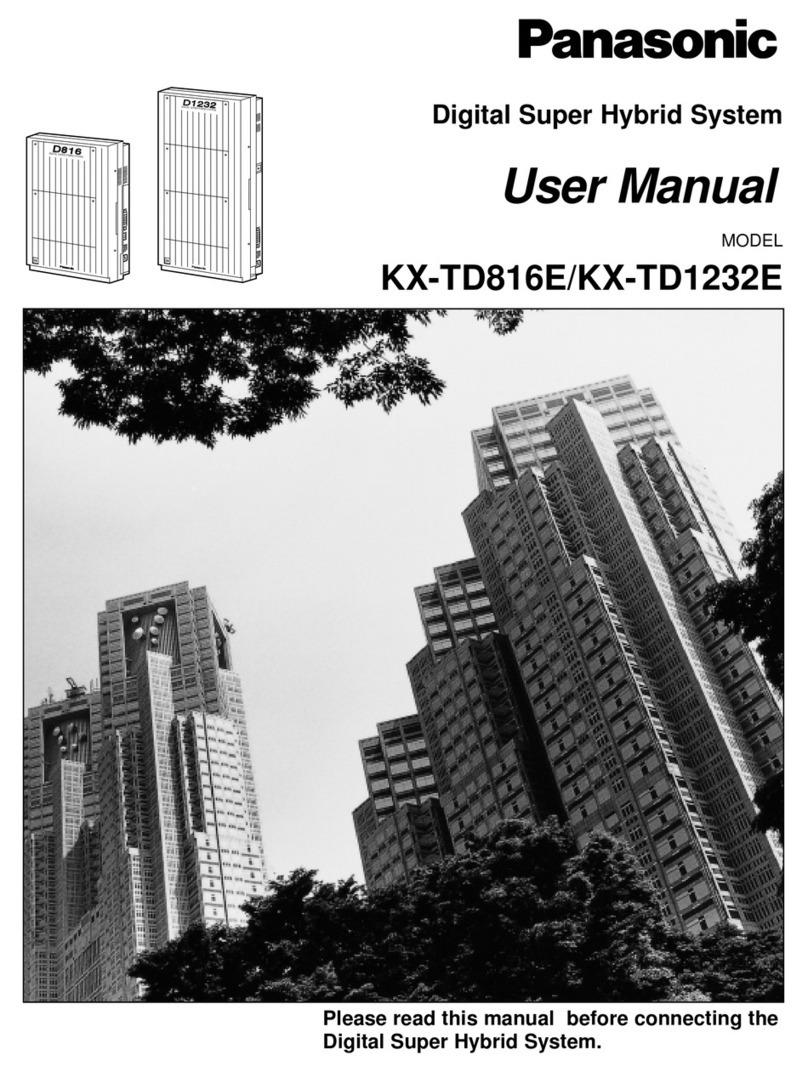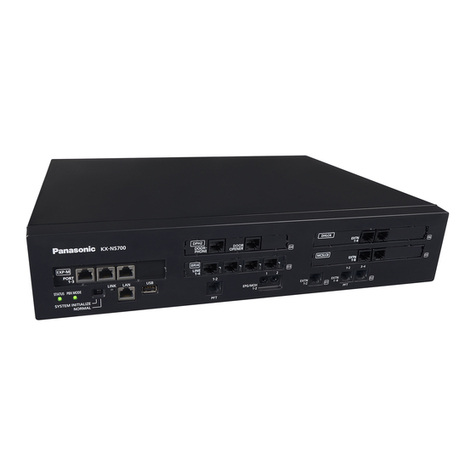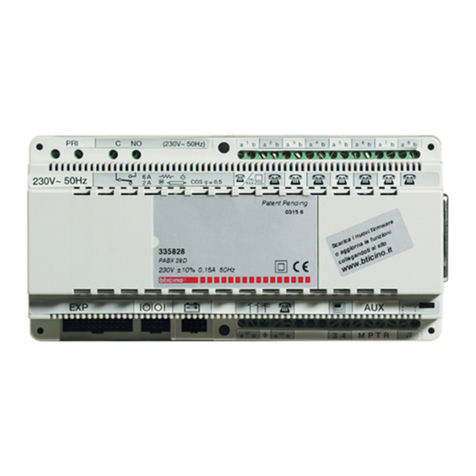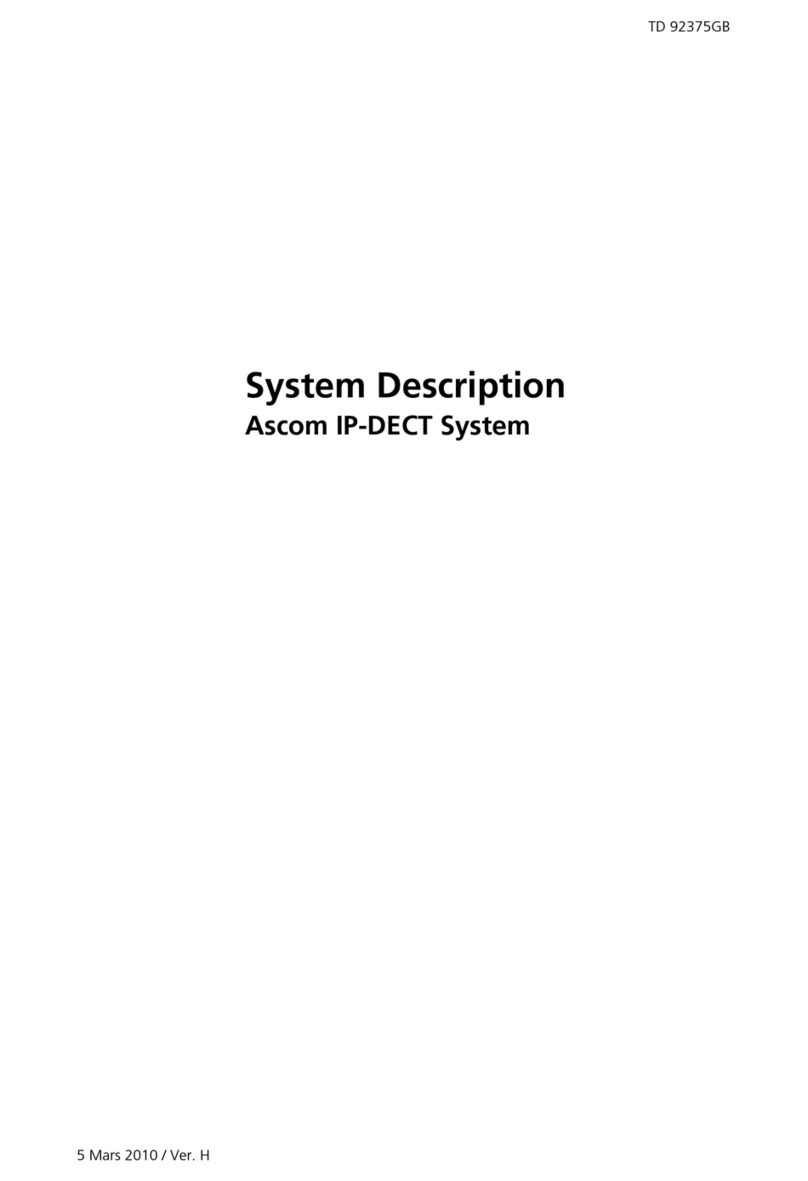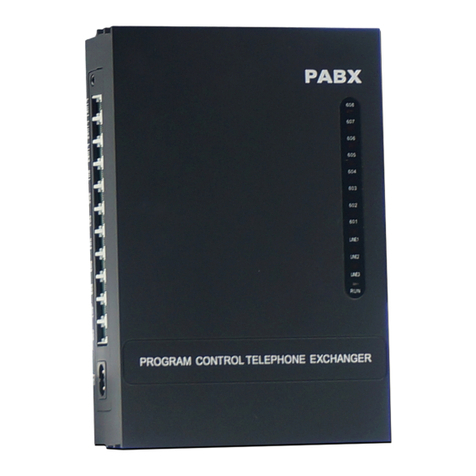Fire-Lite ECC-FFT User manual

B
P/N LS10031-000FL-E:B ECN 13-707
Document LS10031-000FL-E
9/4/2013 Rev:
Firefighter’s Telephone
ECC-FFT
Instruction Manual

2ECC-FFT Instruction Manual — P/N LS10031-000FL-E:B 9/4/2013
Fire Alarm & Emergency Communication System Limitations
While a life safety system may lower insurance rates, it is not a substitute for life and property insurance!
An automatic fire alarm system—typically made up of smoke
detectors, heat detectors, manual pull stations, audible warning
devices, and a fire alarm control panel (FACP) with remote notifi-
cation capability—can provide early warning of a developing fire.
Such a system, however, does not assure protection against
property damage or loss of life resulting from a fire.
An emergency communication system—typically made up of
an automatic fire alarm system (as described above) and a life
safety communication system that may include an autonomous
control unit (ACU), local operating console (LOC), voice commu-
nication, and other various interoperable communication meth-
ods—can broadcast a mass notification message. Such a
system, however, does not assure protection against property
damage or loss of life resulting from a fire or life safety event.
The Manufacturer recommends that smoke and/or heat
detectors be located throughout a protected premises following
the recommendations of the National Fire Protection Association
Standard 72 (NFPA 72), manufacturer's recommendations, State
and local codes, and the recommendations contained in the
Guide for Proper Use of System Smoke Detectors, which is
made available at no charge to all installing dealers. This
document can be found at http://www.systemsensor.com/
appguides/. A study by the Federal Emergency Management
Agency (an agency of the United States government) indicated
that smoke detectors may not go off in as many as 35% of all
fires. While fire alarm systems are designed to provide early
warning against fire, they do not guarantee warning or protection
against fire. A fire alarm system may not provide timely or
adequate warning, or simply may not function, for a variety of
reasons:
Smoke detectors may not sense fire where smoke cannot
reach the detectors such as in chimneys, in or behind walls, on
roofs, or on the other side of closed doors. Smoke detectors
also may not sense a fire on another level or floor of a building.
A second-floor detector, for example, may not sense a first-floor
or basement fire.
Particles of combustion or “smoke” from a developing fire
may not reach the sensing chambers of smoke detectors
because:
• Barriers such as closed or partially closed doors, walls, chim-
neys, even wet or humid areas may inhibit particle or smoke
flow.
• Smoke particles may become “cold,” stratify, and not reach
the ceiling or upper walls where detectors are located.
• Smoke particles may be blown away from detectors by air
outlets, such as air conditioning vents.
• Smoke particles may be drawn into air returns before reach-
ing the detector.
The amount of “smoke” present may be insufficient to alarm
smoke detectors. Smoke detectors are designed to alarm at var-
ious levels of smoke density. If such density levels are not cre-
ated by a developing fire at the location of detectors, the
detectors will not go into alarm.
Smoke detectors, even when working properly, have sensing
limitations. Detectors that have photoelectronic sensing cham-
bers tend to detect smoldering fires better than flaming fires,
which have little visible smoke. Detectors that have ionizing-type
sensing chambers tend to detect fast-flaming fires better than
smoldering fires. Because fires develop in different ways and
are often unpredictable in their growth, neither type of detector is
necessarily best and a given type of detector may not provide
adequate warning of a fire.
Smoke detectors cannot be expected to provide adequate warn-
ing of fires caused by arson, children playing with matches
(especially in bedrooms), smoking in bed, and violent explosions
(caused by escaping gas, improper storage of flammable materi-
als, etc.).
Heat detectors do not sense particles of combustion and alarm
only when heat on their sensors increases at a predetermined
rate or reaches a predetermined level. Rate-of-rise heat detec-
tors may be subject to reduced sensitivity over time. For this
reason, the rate-of-rise feature of each detector should be tested
at least once per year by a qualified fire protection specialist.
Heat detectors are designed to protect property, not life.
IMPORTANT! Smoke detectors must be installed in the same
room as the control panel and in rooms used by the system for
the connection of alarm transmission wiring, communications,
signaling, and/or power. If detectors are not so located, a devel-
oping fire may damage the alarm system, compromising its abil-
ity to report a fire.
Audible warning devices such as bells, horns, strobes,
speakers and displays may not alert people if these devices
are located on the other side of closed or partly open doors or
are located on another floor of a building. Any warning device
may fail to alert people with a disability or those who have
recently consumed drugs, alcohol, or medication. Please note
that:
• An emergency communication system may take priority over
a fire alarm system in the event of a life safety emergency.
• Voice messaging systems must be designed to meet intelligi-
bility requirements as defined by NFPA, local codes, and
Authorities Having Jurisdiction (AHJ).
• Language and instructional requirements must be clearly dis-
seminated on any local displays.
• Strobes can, under certain circumstances, cause seizures in
people with conditions such as epilepsy.
• Studies have shown that certain people, even when they hear
a fire alarm signal, do not respond to or comprehend the
meaning of the signal. Audible devices, such as horns and
bells, can have different tonal patterns and frequencies. It is
the property owner's responsibility to conduct fire drills and
other training exercises to make people aware of fire alarm
signals and instruct them on the proper reaction to alarm sig-
nals.
• In rare instances, the sounding of a warning device can cause
temporary or permanent hearing loss.
A life safety system will not operate without any electrical
power. If AC power fails, the system will operate from standby
batteries only for a specified time and only if the batteries have
been properly maintained and replaced regularly.
Equipment used in the system may not be technically compat-
ible with the control panel. It is essential to use only equipment
listed for service with your control panel.
Telephone lines needed to transmit alarm signals from a prem-
ises to a central monitoring station may be out of service or tem-
porarily disabled. For added protection against telephone line
failure, backup radio transmission systems are recommended.
The most common cause of life safety system malfunction is
inadequate maintenance. To keep the entire life safety system in
excellent working order, ongoing maintenance is required per the
manufacturer's recommendations, and UL and NFPA stan-
dards. At a minimum, the requirements of NFPA 72 shall be fol-
lowed. Environments with large amounts of dust, dirt, or high air
velocity require more frequent maintenance. A maintenance
agreement should be arranged through the local manufacturer's
representative. Maintenance should be scheduled monthly or as
required by National and/or local fire codes and should be per-
formed by authorized professional life saftety system installers
only. Adequate written records of all inspections should be kept.
Limit-D-1-2013

ECC-FFT Instruction Manual — P/N LS10031-000FL-E:B 9/4/2013 3
Installation Precautions
Adherence to the following will aid in problem-free installation with long-term reliability:
WARNING - Several different sources of power can be
connected to the fire alarm control panel. Disconnect all
sources of power before servicing. Control unit and associ-
ated equipment may be damaged by removing and/or insert-
ing cards, modules, or interconnecting cables while the unit is
energized. Do not attempt to install, service, or operate this
unit until manuals are read and understood.
CAUTION - System Re-acceptance Test after Software
Changes: To ensure proper system operation, this product
must be tested in accordance with NFPA 72 after any pro-
gramming operation or change in site-specific software. Re-
acceptance testing is required after any change, addition or
deletion of system components, or after any modification,
repair or adjustment to system hardware or wiring. All compo-
nents, circuits, system operations, or software functions known
to be affected by a change must be 100% tested. In addition,
to ensure that other operations are not inadvertently affected,
at least 10% of initiating devices that are not directly affected
by the change, up to a maximum of 50 devices, must also be
tested and proper system operation verified.
This system meets NFPA requirements for operation at 0-49º
C/32-120º F and at a relative humidity 93% ± 2% RH (non-
condensing) at 32°C ± 2°C (90°F ± 3°F). However, the useful
life of the system's standby batteries and the electronic com-
ponents may be adversely affected by extreme temperature
ranges and humidity. Therefore, it is recommended that this
system and its peripherals be installed in an environment with
a normal room temperature of 15-27º C/60-80º F.
Verify that wire sizes are adequate for all initiating and indi-
cating device loops. Most devices cannot tolerate more than a
10% I.R. drop from the specified device voltage.
Like all solid state electronic devices, this system may
operate erratically or can be damaged when subjected to light-
ning induced transients. Although no system is completely
immune from lightning transients and interference, proper
grounding will reduce susceptibility. Overhead or outside aerial
wiring is not recommended, due to an increased susceptibility
to nearby lightning strikes. Consult with the Technical Ser-
vices Department if any problems are anticipated or encoun-
tered.
Disconnect AC power and batteries prior to removing or
inserting circuit boards. Failure to do so can damage circuits.
Remove all electronic assemblies prior to any drilling, filing,
reaming, or punching of the enclosure. When possible, make
all cable entries from the sides or rear. Before making modifi-
cations, verify that they will not interfere with battery, trans-
former, or printed circuit board location.
Do not tighten screw terminals more than 9 in-lbs. Over-
tightening may damage threads, resulting in reduced terminal
contact pressure and difficulty with screw terminal removal.
This system contains static-sensitive components.
Always ground yourself with a proper wrist strap before han-
dling any circuits so that static charges are removed from the
body. Use static suppressive packaging to protect electronic
assemblies removed from the unit.
Follow the instructions in the installation, operating, and pro-
gramming manuals. These instructions must be followed to
avoid damage to the control panel and associated equipment.
FACP operation and reliability depend upon proper installation.
Precau-D1-9-2005
FCC Warning
WARNING: This equipment generates, uses, and can
radiate radio frequency energy and if not installed and
used in accordance with the instruction manual may
cause interference to radio communications. It has been
tested and found to comply with the limits for class A
computing devices pursuant to Subpart B of Part 15 of
FCC Rules, which is designed to provide reasonable
protection against such interference when devices are
operated in a commercial environment. Operation of this
equipment in a residential area is likely to cause interfer-
ence, in which case the user will be required to correct
the interference at his or her own expense.
Canadian Requirements
This digital apparatus does not exceed the Class A limits
for radiation noise emissions from digital apparatus set
out in the Radio Interference Regulations of the Cana-
dian Department of Communications.
Le present appareil numerique n'emet pas de bruits
radioelectriques depassant les limites applicables aux
appareils numeriques de la classe A prescrites dans le
Reglement sur le brouillage radioelectrique edicte par le
ministere des Communications du Canada.
LiteSpeed™ is a trademark; and FireLite® Alarms is a registered trademark of Honeywell International Inc. Microsoft® and Windows® are registered
trademarks of the Microsoft Corporation.
©2013 by Honeywell International Inc. All rights reserved. Unauthorized use of this document is strictly prohibited.

4ECC-FFT Instruction Manual — P/N LS10031-000FL-E:B 9/4/2013
Software Downloads
In order to supply the latest features and functionality in fire alarm and life safety technology to our customers, we make
frequent upgrades to the embedded software in our products. To ensure that you are installing and programming the latest
features, we strongly recommend that you download the most current version of software for each product prior to
commissioning any system. Contact Technical Support with any questions about software and the appropriate version for a
specific application.
Documentation Feedback
Your feedback helps us keep our documentation up-to-date and accurate. If you have any comments or suggestions about our
online Help or printed manuals, you can email us.
Please include the following information:
•Product name and version number (if applicable)
•Printed manual or online Help
•Topic Title (for online Help)
•Page number (for printed manual)
•Brief description of content you think should be improved or corrected
•Your suggestion for how to correct/improve documentation
Send email messages to:
FireSystems.T[email protected]
Please note this email address is for documentation feedback only. If you have any technical issues, please contact Technical
Services.

ECC-FFT Instruction Manual — P/N LS10031-000FL-E:B 9/4/2013 5
Table of Contents
Section 1: Product Description ...............................................................................................7
1.1: Features..........................................................................................................................................................7
1.2: Optional Accessories .....................................................................................................................................7
1.3: Compatible Devices.......................................................................................................................................7
1.4: ECC-FFT Board Layout ................................................................................................................................8
1.5: Electrical Specifications ................................................................................................................................9
1.5.1: Power Requirements............................................................................................................................9
1.5.2: Current Ratings....................................................................................................................................9
1.5.3: Wiring Specifications ........................................................................................................................10
Section 2: Installation............................................................................................................. 11
2.1: Mounting Options........................................................................................................................................11
2.2: Backbox Installation ....................................................................................................................................11
2.3: Installing the ECC-FFT ...............................................................................................................................13
2.3.1: Operating Power................................................................................................................................13
2.3.2: DIP switch settings on ECC-FFT ......................................................................................................13
DIP Switch............................................................................................................................................13
2.4: UL Power-limited Wiring Requirements.....................................................................................................14
2.5: ECC-FFT Fire Fighter Telephone Module Connection...............................................................................15
2.6: FPJ-F Installation.........................................................................................................................................16
2.7: SLC Device Installation...............................................................................................................................17
2.7.1: List of SLC Devices ..........................................................................................................................17
2.7.2: Maximum Number of Devices ..........................................................................................................17
2.7.3: Wiring Requirements for SLC Device ..............................................................................................17
Wiring SLC in Style 4 (Class B) Configuration...................................................................................17
Wiring SLC Devices in Style 6 & 7 (Class A) Configuration .............................................................19
2.7.4: Addressing MMF-301 SLC Devices .................................................................................................19
2.8: Audio Phone Circuit Installation .................................................................................................................20
2.8.1: Maximum Number of Devices ..........................................................................................................20
2.8.2: Wiring Requirements for the Audio Telephone Circuit ....................................................................20
Single Phone Jack Audio Circuit in Class B Configuration.................................................................21
Single Phone Jack Audio Circuit in Class A Configuration.................................................................22
Multi-Phone Jack Audio Circuit in Class B Configuration..................................................................23
Multi-Phone Jack Audio Circuit in Class A Configuration..................................................................24
Telephone Jack Only Audio Circuit .....................................................................................................25
Section 3: System Operation................................................................................................. 27
3.1: Push-button Operations ...............................................................................................................................27
3.2: LED Operations ...........................................................................................................................................27
3.3: Autoprogram Operation...............................................................................................................................28

6ECC-FFT Instruction Manual — P/N LS10031-000FL-E:B 9/4/2013
This control panel has been designed to comply with standards set forth by the following regulatory agencies:
• Underwriters Laboratories/Underwriters Laboratories Canada
• National Fire Protection Association
NFPA Standards
This Fire Alarm Control Panel complies with the following NFPA Standards:
NFPA 72 National Fire Alarm Code
Note: Audible signal appliances used in public mode applications, are required to have
minimum sound levels of 75 dBA at 10 feet (3 meters) and a maximum level of 120 dBA at the
minimum hearing distance from the audible appliance.
To ensure that the appliance is clearly heard, the audible appliance sound level must be at least
15 dBA above the average ambient sound level or 5 dBA above the maximum sound level with
a duration of at least 60 seconds, depending on which level is greater, with the sound level
being measured 5 feet (1.5 meters) above the floor.
Underwriters Laboratories Documents:
UL 38 Manually Actuated Signaling Boxes
UL 464 Audible Signaling Appliances
UL 864 Standard for Control Units for Fire Protective Signaling Systems
UL 1480 Speakers for Fire Protective Signaling Systems
UL 1481 Power Supplies for Fire Protective Signaling Systems
UL 1638 Visual Signaling Appliances
UL 1711 Amplifiers for Fire Protective Signaling Systems
UL 1971 Signaling Devices for Hearing Impaired
UL 2572 Communication and Control Units for Mass Notification Systems
NEC Article 250 Grounding
NEC Article 300 Wiring Methods
NEC Article 760 Fire Protective Signaling Systems
UFC Unified Facilities Criteria UFC 4-021-01: Mass Notification Systems
Applicable Local and State Building Codes
Requirements of the Local Authority Having Jurisdiction (LAHJ)
Fire•Lite Documents
Fire•Lite Device Compatibility Document Document #15384
ECC-50/100 Manual Document #LS10001-000FL-E
ECC-50/125DA Manual Document #LS10027-000FL-E
MS-9200UDLS Series Manual Document #52750
MS-9600(UD)LS Technical Manual Document #52646
FCPS-24FS6/8 Field Charger/Power Supply Document #51883
HP300ULX Power Supply Document # 52386
This product has been certified to comply with the requirements in the Standard for Control Units and Accessories for Fire
Alarm Systems, UL 864, 9th Edition. Operation of this product with products not tested for UL 864, 9th Edition has not
been evaluated. Such operation requires the approval of the local Authority Having Jurisdiction (AHJ).
Before proceeding, the installer should be familiar with the following documents.

ECC-FFT Instruction Manual — P/N LS10031-000FL-E:B 9/4/2013 7
Section 1: Product Description
An ECC-FFT Fire Fighter Telephone System provides supervision, annunciation, and control for
local and remote telephone handsets. The ECC-FFT with keypad, provides indications of phone
activation, and corresponding trouble conditions.
1.1 Features
• One Form-C system trouble relay - TB6
• ECC-FFT Fire Fighter Telephone module for control and annunciation of up to 24 remote
telephone jacks
• A maximum of ten (10) Fire Fighter Remote Handsets (FHS-F) can be used at one time to
communicate over the telephone circuit connected to the ECC-FFT
• Fire Fighter Phone Jack (FPJ-F) provides a plug-in location for the FHS-F
• Fire Fighter Handset Cabinet (FHSC-RF/SF) is used to store up to five (5) Fire Fighter
Handsets (FHS-F)
• System Status LEDs
1.2 Optional Accessories
This manual also contains information on how to install the following compatible accessories with
the FFT series equipment:
1.3 Compatible Devices
Table 1.1 lists the available FireLite fire alarm control panels/systems and power supplies compati-
ble with the ECC-FFT.
Model Number Description
FPJ-F Remote Phone Jack
FHS-F Fire Fighters Remote Handset
FHSC-RF Fire Fighters Handset Cabinet Recessed
FHSC-SF Fire Fighters Handset Cabinet Surface Mount
MMF-301 Addressable Mini-Monitor Module
I300 SLC Line Isolation Module
Model Manual PN
ECC-50/100 Emergency Command Center LS10001-000FL-E
MS-9200UDLS Addressable Fire Alarm Control Panel 52750
MS-9600(UD)LS Addressable Fire Alarm Control Panel 52646
FCPS-24FS6/8 Field Charger/Power Supply 51883
Table 1.1 Compatible Powering Devices

8ECC-FFT Instruction Manual — P/N LS10031-000FL-E:B 9/4/2013
Product Description ECC-FFT Board Layout
1.4 ECC-FFT Board Layout
Figure 1.1 above shows the circuit board that attaches to the cabinet. If you should need to remove
the board assembly for repair, remove the seven mounting nuts which hold the assembly in the cab-
inet. Then lift the control board out of the cabinet.
ON
12345
6
SLC OUT SLC IN PHONE OUT PHONE IN
- + - + - + - +
-
+
A
B
TROUBLE
NO COM NC
1
2
3
4
Autoprogram AcceptStatus LEDs
Local Handset
piezo
Phone In
Phone Out
SLC IN
SLC Out
mounting stud
mounting studs
Supervised,
Power-Limited
All circuits are inherently power-limited
except the trouble relay
Not
Used
DC
Power
System Trouble Relay
Non Power-Limited
mounting studs
mounting stud
mounting stud
Figure 1.1 Back view of ECC-FFT
DIP Switch
fftbrd.wmf
Power Status LED

ECC-FFT Instruction Manual — P/N LS10031-000FL-E:B 9/4/2013 9
Electrical Specifications Product Description
1.5 Electrical Specifications
1.5.1 Power Requirements
Voltage for the ECC-FFT must be a UL-listed, power-limited, filtered, non-resettable nominal 24
VDC source. The voltage source must be within the range of 17-29 VDC.
1.5.2 Current Ratings
Maximum current ratings for determining backup battery requirements for alarm (active) and
standby conditions over the input voltage range of 17-29 VDC are shown in Table 1.3 below.
Zone 1-
Zone 8
Zone 9 -
Zone 16
Zone 17 -
Zone 24
Figure 1.2 ECC-FFT Keypad
eccfftkypd.wmf
Circuits Voltage Current
SLC Circuit 32 V 150 mA
Audio Circuits 17 V 53 mA
Trouble Relay 12 VDC 1 A
Table 1.2 Electrical Ratings
Active Standby
ECC-FFT 230 mA 120 mA
Table 1.3 ECC-FFT Current Draw

10 ECC-FFT Instruction Manual — P/N LS10031-000FL-E:B 9/4/2013
Product Description Electrical Specifications
1.5.3 Wiring Specifications
Induced noise (transfer of electrical energy from one wire to another) can interfere with telephone
communication or cause false alarms. To avoid induced noise, follow these guidelines:
• Isolate input wiring from high current output and power wiring. Do not pull one multi-
conductor cable for the entire panel. Instead, separate the wiring as follows:
– SLC Loops
– Relay Circuit
– Audio Circuits
• Do not pull wires from different circuits (listed above) through the same conduit. If you must
run them together, do so for as short a distance as possible or use shielded cable. Twisted,
shielded wire on the Audio Circuits is recommended for maximum protection against EMI and
AFI emissions and susceptibility. Connect the shield to earth ground at the panel. You must
route high and low voltages separately.
• Route the wiring around the inside perimeter of the cabinet. It should not cross the circuit
board where it could induce noise into the sensitive microelectronics or pick up unwanted RF
noise from the high speed circuits. See Figure 2.4 for an example.
• High frequency noise, such as that produced by the inductive reactance of a speaker or bell,
can also be reduced by running the wire through ferrite shield beads or by wrapping it around a
ferrite toroid.

ECC-FFT Instruction Manual — P/N LS10031-000FL-E:B 9/4/2013 11
Section 2: Installation
2.1 Mounting Options
The cabinet may be semi-flush or surface mounted. The cabinet mounts using three key slots at the
top of the backbox and two additional 0.250" diameter holes located at the bottom.
Carefully unpack the system and check for shipping damage. Mount the cabinet in a clean, dry,
vibration-free area where extreme temperatures are not encountered. The area should be readily
accessible with sufficient room to easily install and maintain the panel. Locate the top of the cabi-
net approximately five feet above the floor with the hinge mounting on the left. Determine the
number of conductors required for the devices to be installed. Sufficient knockouts are provided
for wiring convenience. Select the appropriate knockout(s) and pull the required conductors into
the box. Note that knockouts are also located on the back of the cabinet. All wiring should be in
accordance with the National and/or Local codes for fire alarm systems.
2.2 Backbox Installation
1. Open the door and lift the door off the pin hinges.
2. Loosen the two (2) screws that secure the dress panel to the backbox. Then, lift up to swing
the dress panel open.
3. Disconnect the ground wire from the dress panel.
4. Lift the dress panel up and gently pull the lower hinge out of the backbox. Gently pull down to
remove the top hinge. Store the dress panel in a safe place.
5. Mark and predrill hole in the wall for the center top keyhole mounting bolt using the
dimensions illustrated in Figure 2.2 on page 12.
6. Install center top fastener in the wall with the screw head protruding.
!
CAUTION: STATIC SENSITIVE COMPONENTS
THE CIRCUIT BOARD CONTAINS STATIC-SENSITIVE COMPONENTS. ALWAYS GROUND
YOURSELF WITH A PROPER WRIST STRAP BEFORE HANDLING ANY BOARDS SO THAT
STATIC CHARGES ARE REMOVED FROM THE BODY. USE STATIC SUPPRESSIVE PACKAG-
ING TO PROTECT ELECTRONIC ASSEMBLIES.
ON
12345
6
SLC OUT SLC IN PHONE OUT PHONE IN
-+-+ -+- +
-+AB
TROUBLE
NO COM NC
1
2
3
4
remove screws
disconnect
earth ground
lift up dress panel,
pull out,
slide down to remove
Figure 2.1 Dress Panel Removal
fft-dpopn.wmf

12 ECC-FFT Instruction Manual — P/N LS10031-000FL-E:B 9/4/2013
Installation Backbox Installation
7. Place backbox over the top screw, level and secure.
8. Mark and drill the left and right upper and lower mounting holes.
Note: Outer holes (closest to sidewall) are used for 16” O.C. stud mounting.
9. Install remaining fasteners and tighten.
10. Carefully reinstall the chassis assembly and dress panel by reversing the steps above. Use
appropriate precautions to prevent damage to components due to static discharge.
11. Draw wires through the respective knockout locations.
An optional Trim Ring (P/N TR-CE) is available for semi-flush mount installations.
Figure 2.2 Cabinet Dimensions & Knockout Locations
9050udencl.wmf
Semi-Flush Mounting
Do not recess box more
than 3.875” into wall to
avoid covering venting
holes on top of box.
Hinge Slot for
Dress Panel
Hinge Slot for
Dress Panel
Semi-flush
mounting hole
Mounting
slots for
optional
Trim Ring

ECC-FFT Instruction Manual — P/N LS10031-000FL-E:B 9/4/2013 13
Installing the ECC-FFT Installation
2.3 Installing the ECC-FFT
2.3.1 Operating Power
Connect the ECC-FFT to the appropriate DC power source. See Section 1.3 for compatible equip-
ment and Section 1.5 for power requirements.
2.3.2 DIP switch settings on ECC-FFT
Use the on-board DIP switch to assign the configuration setting to the ECC-FFT.
1. Refer to Figure 2.3 for location of the DIP switches on the ECC-FFT board.
2. Configure the ECC-FFT using the dip switch settings in Table 2.1. Add SLC modules to the
system through Autoprogram feature. See Section 3.3 for Autoprogram Operation.
DIP Switch
DIP Switch ON OFF
1 SLC Devices Installed SLC Devices not Installed
2 Trouble Piezo Enabled Trouble Piezo Disabled
3 SLC Class A Supervision SLC Class B Supervision
4 Phone Circuit Class A Supervision Phone Circuit Class B Supervision
5 Not Used Leave in OFF position
6 Not Used Leave in OFF position
Table 2.1 ECC-FFT DIP Switch Configurations
Figure 2.3 DIP Switch

14 ECC-FFT Instruction Manual — P/N LS10031-000FL-E:B 9/4/2013
Installation UL Power-limited Wiring Requirements
2.4 UL Power-limited Wiring Requirements
Power-limited and nonpower-limited circuit wiring must remain separated in the cabinet. All
power-limited circuit wiring must remain at least 0.25” (6.35 mm) away from any nonpower-lim-
ited circuit wiring and nonpower-limited circuit wiring must enter and exit the cabinet through dif-
ferent knockouts and/or conduits. A typical wiring diagram for the ECC-FFT is shown below.
Figure 2.4 UL Power-Limited Wiring Requirements
back view of dress panel
Note: The dress panel is shown swung
open for illustration purposes only.
Nonpower-
limited
circuit
Power-limited
circuits
fftulpwr.wmf

ECC-FFT Instruction Manual — P/N LS10031-000FL-E:B 9/4/2013 15
ECC-FFT Fire Fighter Telephone Module Connection Installation
2.5 ECC-FFT Fire Fighter Telephone Module Connection
The ECC-FFT provides connection for a single Class B or Class A telephone audio circuit. See
page 21 through page 26 for examples of audio zone configurations. An MMF-301 monitor module
can be used to monitor the connection of the Fire Fighter Telephone remote handset (FHS-F) into
the FPJ-F, which is then displayed on the ECC-FFT active zone LED during the Autoprogram fea-
ture.
0
10
11
12
13
14 15
ADDRESS
LOOP
1
2
3
4
TENS ONES
6
7
8
95
01
2
3
4
6
7
8
95
TB1
TB2
3
2
1
1
2
3
+ -
+-
To FFT - SLC Terminal TB4
Connectors or other MMF-301
The wiring between the monitor
module and FPJ-F is supervised
by the monitor module. A 47K
End-of-Line resistor is built into
the FPJ-F.
To FFT-Phone TB4 phone
In/Out + – connections or other
FPJ-Fs
4.7K, 1/2 watt ELR
(install on last device for Style Y
[Class B] telephone circuit only
FFT-FPJ
Figure 2.5 ECC-FFT Connections
violet
yellow
black
red

16 ECC-FFT Instruction Manual — P/N LS10031-000FL-E:B 9/4/2013
Installation FPJ-F Installation
2.6 FPJ-F Installation
The FPJ-F Firefighter Phone Jack mounts to a single-gang electrical box (4 x 2⅛x 2½) or, when
the addressable mini-monitor module is installed with it, a deep single-gang electrical box (4" x
2⅛” x 3¼”).
Connect the telephone audio loop between the FPJ-F and FFT as detailed below. All circuits are
power-limited and supervised.
Figure 2.6 FPJ-F (Phone Jack) and FHS-F (Handset)
0
10
11
12
13
14 15
ADDRESS
LOOP
1
2
3
4
TENS ONES
6
7
8
95
0
1
2
3
4
6
7
8
9
5
TB1
TB2
3
2
1
1
2
3
+ -
+
-
SLC
PHONE PHONE
OUT
OUT
IN
IN
SLC
- + - + - + - +
Figure 2.7 FFT to FPJ-F Connection
Class A wiring
Audio
Audio
To FFT-SLC
terminal TB4
connectors or other
MMF-301s
4.7K, ½ watt ELR
(install on last device
for Style Y [Class B]
telephone circuit only)
contact ELR connected
FFT
FPJ-F

ECC-FFT Instruction Manual — P/N LS10031-000FL-E:B 9/4/2013 17
SLC Device Installation Installation
2.7 SLC Device Installation
2.7.1 List of SLC Devices
The following SLC device can be used with the Fire Fighters Phone. See the device installation
instructions for more information (packaged with the device). Refer also to the SLC Wiring Man-
ual #51309for more information.
2.7.2 Maximum Number of Devices
The ECC-FFT supports up to 24 MMF-301 devices on one FFT system.
2.7.3 Wiring Requirements for SLC Device
The following information applies to the MMF-301 - Mini Monitor module.
Wiring SLC in Style 4 (Class B) Configuration
No special wire is required for the ECC-FFT SLC loop. The wire can be untwisted, unshielded,
solid or stranded as long as it meets the National Electric Code 760-51 requirements for power lim-
ited fire protective signaling cables. Wire distances are computed using copper wire.
Maximum wiring resistance is 40 ohms to the farthest SLC device.
Maximum loop length depends on the wire gauge.
!
WARNING: RISK OF EQUIPMENT DAMAGE AND PERSONAL INJURY
SEVERAL DIFFERENT SOURCES OF POWER CAN BE CONNECTED TO THIS UNIT. ALWAYS
DISCONNECT ALL SOURCES OF POWER BEFORE INSTALLING OR SERVICING.
Part Number Model Name/Description Install Sheet PN
MMF-301 Mini Monitor Module I56-3654
I300 Fault Isolator Module I56-1381
Wire Gauge Max. Distance
22 AWG 1200 feet
18 AWG 3100 feet
16 AWG 4900 feet
14 AWG 7900 feet
12 AWG 10,000 feet

18 ECC-FFT Instruction Manual — P/N LS10031-000FL-E:B 9/4/2013
Installation SLC Device Installation
Figure 2.8 and Figure 2.9 show how length is determined for out and return style wiring.
When using T-taps, the total length of all taps and the main bus must not exceed 40,000 feet. This
requirement must be met in addition to the maximum distance requirements for the various wire
gauges.
Figure 2.8 Calculating Wire Run Length
The dotted line path shows how the
wire distance is calculated for the
SLC device at the end of the run.
The wire distance must be less than
the maximum per wire gauge.
SLC device
SLC device
SLC device
SLC device max loop resistance = 40 ohms
SLC Circuit
Figure 2.9 Calculating Wire Run Length for a T-tap
In this example:
= 1000 feet
= 1600 feet
= 3500 feet
16 AWG wire can be used
because the greatest distance is
3500 feet
The device located farthest from
the SLC must be less than the
maximum distance per wire gauge.
SLC device
SLC device
SLC device
SLC device max loop resistance = 40 ohms
SLC Circuit

ECC-FFT Instruction Manual — P/N LS10031-000FL-E:B 9/4/2013 19
SLC Device Installation Installation
Wiring SLC Devices in Style 6 & 7 (Class A) Configuration
Figure 2.10 illustrates how to wire the SLC loop for Style 6 or Style 7 Class A installations.
.
2.7.4 Addressing MMF-301 SLC Devices
All MMF-301 devices are addressed using the two rotary dials that appear on the device board. Use
the ONES rotary dial to set the ones place in a one or two digit number, and use the TENS rotary
dial to set the tens place in a two digit number.
MMF-301 modules can be assigned any unique address from 1 to 24.
NOTE: Style 6 does not require the use of short circuit isolator devices.
MMISO ISO ISO ISO ISO ISO
ISOISOISOISOISO ISO
MM MM
MMMM
MM
ISO
= SLC Device, Mini monitor module, MMF-301
= Isolator Device, I300
MMISO
ISO
MM MM
MMMM
MM MM
MM
SLC
Circuit
SLC
Circuit
SLC IN
SLC OUT
+
-
+
-
SLC IN
SLC OUT
+
-
+
-
Note: A maximum of 20
isolator modules can be
attached to the ECC-FFT
Style 6 Wring
Style 7 Wring
Figure 2.10 Class A SLC Configuration
Wires must be in conduit and close-nippled if isolator modules are used.
Wires must be in conduit and close-nippled at the
control panel and on each side of all devices.
NOTE: T-taps are not allowed on Class A SLC loops.
!
CAUTION: PROPER SYSTEM SUPERVISION
FOR PROPER SYSTEM SUPERVISION DO NOT USE LOOPED WIRE UNDER TERMINALS
MARKED SLC + AND – OF THE SLC DEVICE CONNECTORS. BREAK WIRE RUNS TO PROVIDE
SUPERVISION OF CONNECTIONS.

20 ECC-FFT Instruction Manual — P/N LS10031-000FL-E:B 9/4/2013
Installation Audio Phone Circuit Installation
Example 1: To select device address 10, turn the ONES rotary dial to 0and the TENS rotary dial to
1as shown below.
Example 2: To select device address 42, turn the ONES rotary dial to 2and the TENS rotary dial to
4as show below.
2.8 Audio Phone Circuit Installation
2.8.1 Maximum Number of Devices
The ECC-FFT supports up to 24 zones. Each zone consists of one addressable monitor module
(MMF-301) and a minimum of one Fire Fighter Telephone Jack (FPJ-F).
2.8.2 Wiring Requirements for the Audio Telephone Circuit
No special wire is required for the Audio Telephone Circuit. The wire can be untwisted, unshielded,
twisted or shielded as long as it meets the National Electric code 760-51 requirements for power
limited fire protective signaling cables.
54 Ohm maximum impedance - 12 to 18 AWG.
Twisted, shielded wire is recommended for maximum protection against EMI and AFI emissions
and susceptibility.
If using shielded cable, attach the shield to Grounding Stud below TB6 of the FFT.
Example 1: MMF-301 SLC Device set to Address 10
Example 2: MMF-301 SLC Device set to Address 42
NOTE: Do not ground the shield on both ends.
Table of contents

